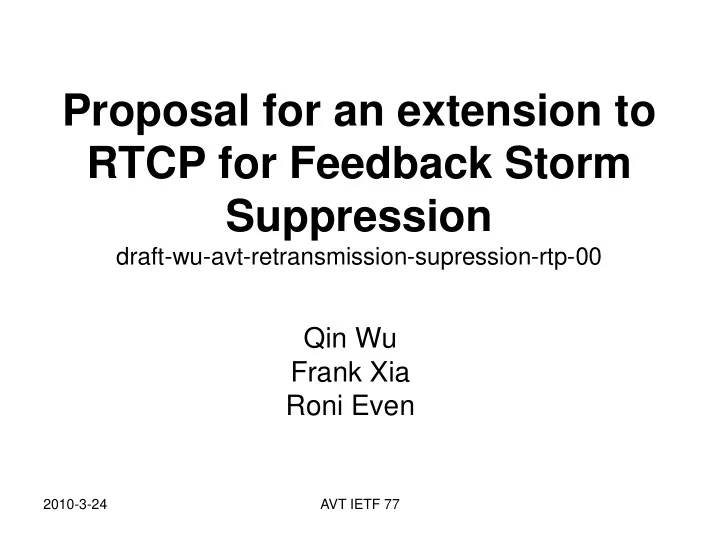

Proposal for an extension to RTCP for Feedback Storm Suppression draft-wu-avt-retransmission-supression-rtp-00 Qin Wu Frank Xia Roni Even 2010-3-24 AVT IETF 77
Proposal for an extension to RTCP for Feedback Storm Suppression • Objective – Define a one generic RTCP receiver report designed to suppress massive NAK implosion and Fast update implosion. • Motivation – Prevent or reduce NACK implosion or Update request implosion occurring in upstream link of intermediate node or downstream aggregate link of intermediate node – Send one new RTCP receiver report to make receiver know packet loss request (e.g., NACK, fast update request) is not needed – What if the network detect packet loss after the receivers send out packet loss request – What if the network detect packet loss before the receiver send out packet loss request – Work at least in Simple Feedback and in Distribution Source Feedback Summary Models defined in [I-D.ietf-avt-rtcpssm]. 2010-3-24 AVT IETF 77
Proposal for an extension to RTCP for Feedback Storm Suppression • Network side operation – Packet loss detected by network before hosts send out packet loss request • The Intermediate node may send this new RTCP receiver report to the receivers when detecting a loss on its incoming link while send a packet loss request to the media sender. – Packet loss detected by network after hosts send out packet loss request • The Intermediate node may receive packet loss request (e.g., NACK or Fast update request) messages from the receivers and may filter them out if it already sent a packet loss request for the requested packet to the media source. • Receiver operation – If the receiver understands this message it will not send packet loss request for the missing packets reported in the message and will accept a retransmission stream. – The receiver may send packet loss request messages if it did not understand this new message. 2010-3-24 AVT IETF 77
Mailing List Discussion Summarization • Using NACK sent from sender for suppression – why bother to invent a whole new packet format when NAK does exactly what you want. – require to add the semantics of suppression when sent by the media sender – Need to distinguish NACK sent from receiver and NACK sent from sender – Using NACk as Upstream receiver report, Forward upstream receiver report by Retransmission server to all the receivers – can be mentioned but I assume that it does not require any specific protocol on top of the NACK suppression message, and is just an implementation example. • Downstream receiver report – Using signaling for configuring part of the RTP receivers to act as reporters – A small subset of RTP receivers are "immediate" (packet loss) reporters – Based on SSRC of the RTP receiver to distinguish whether it is immediate reporter – we can look at it, we may need to verify if it can be done in AVT • Which network segment is packet loss happening most – network segment between DS and the RTP_Rxs represent largest part of network where Packet loss occurs most – Question on this segment is covered, otherwise it is weak part – NACK Storm happening between DS and RTP_Rx is also covered – But need to distinguish downstream aggregate link and downstream access link 2010-3-24 AVT IETF 77
Open issues / Questions • Define one generic mechanism for Storm implosion – Prevent Storm implosion including NACK implosion and Fast Update request implosion – Do we need more use cases for storm implosion – NACK is option? • Message Format for Storm Suppression – Transport layer feedback message or Payload-Specific feedback message? – Variants of extension to RTCP receiver report • Do we need to define a few more extension to RTCP receiver report • Do we need to distinguish NACK implosion and Update request implosion 2010-3-24 AVT IETF 77
Proposal – Request to accept draft as WG item • Got already supporter in the list – Encourage more review of draft and early feedback 2010-3-24 AVT IETF 77
Appendix1:Problem description • Packet loss occurs upstream link and downstream aggregated link of DS between the media sender and the receivers due to oversaturated network link, faulty networking hardware or corrupted packets rejected in-transit. Home R1 Gateway Access Link 1 Media Distribution Aggregate Sender Source (DS) Downstream Switch R2 aggregate link Upstrea Access Link 2 m link R3 Access Link 3 R4 Network Provider End User Service Provider Content Provider • Massive retransmission request for the same RTP packets through RTCP NACK to the same multicast sender may result in NACK implosion • To increase the robustness to the loss of a NACK or of a retransmission packet, a receiver may also send multiple NACKs for the same packet, NACK implosion may become worsening. 2010-3-24 AVT IETF 77
Appendix2:Additional scenarios for Fast Update request Implosion • Packet loss occurs upstream link and downstream aggregated link of MCU between the media sender and the receivers due to oversaturated network link, faulty networking hardware or corrupted packets rejected in-transit. Home R1 Gateway Access Link 1 Media Multipoint Control Aggregate Sender Unit (MCU) Downstream Switch R2 aggregate link Upstrea Access Link 2 m link R3 Access Link 3 R4 End User Network Provider Service Provider Content Provider • Massive fast update request for the same RTP packets to the same multicast sender may result in Fast update request implosion • As described in RFC 5104, Fast update request is known as Full intra request (FIR). 2010-3-24 AVT IETF 77
Recommend
More recommend